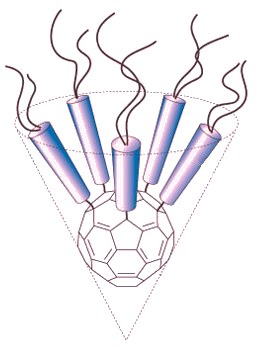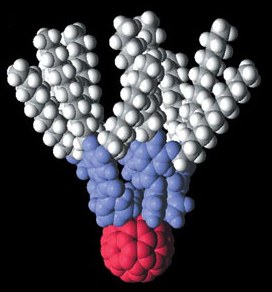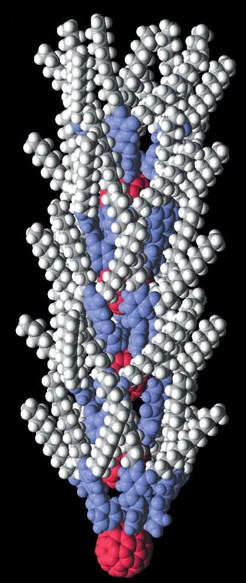A molecule shaped like a badminton shuttlecock with a buckyball molecule at the base and five rod-like compounds forming the feathers has been made by Japanese chemists. This spectacular molecule stacks with others of its kind, just like a pile of real-life shuttlecocks. However, on the molecular scale these shuttlecocks display liquid crystal behaviour and could find use in new organic-based electronics devices.
Liquid crystals (LCs) flow like fluids, but have regularity and the direction-dependent properties more commonly seen in solid crystals. These characteristics have been brought to bear in a number of devices, such as flat-panel displays (LCDs). An applied electric field is used to change the organization of the liquid crystals and display an image.

The shuttlecock
Materials scientists continue to look for novel liquid crystals with potential as non-linear optical devices for fibre-optic communication and tuning lasers and other technologies. Now, Eiichi Nakamura of the University of Tokyo and colleagues have synthesised a whole new class of liquid crystals.
Their new LCs are based on the soccer-ball shaped all-carbon molecule known colloquially as the buckyball. Buckyballs, or fullerenes to give them their proper name, represent the third major form, or allotrope, of carbon after graphite and diamond.

3D shuttlecock structure
Nakamura and his team have used the [60]fullerene molecule as the base of a shuttlecock-shaped molecule that display liquid crystal behaviour.

Stack ’em high 3D structure
The molecular shuttlecocks, with their idealistically conical shape, stack together to form columns. The molecules stack together because of attraction between the spherical fullerene base and the cone-shaped part of the next molecule in the stack. By attaching feather-like units with different chemical properties the researchers can make different versions of their liquid crystals.
According to Carsten Tschierske of the Martin-Luther-University Halle-Wittenberg, Halle Saale, Germany, writing in the journal Nature, Many of the advances in LC research have been stimulated by fresh designs of molecules that form new LC phases. In their ‘shuttlecock’ molecules, Sawamura et al have undoubtedly provided a new design principle for research teams to play with. He adds that, The polar order within the columns is especially interesting and could possibly lead to macroscopically polar structures which could be of interest for nonlinear optics and other applications.
Nakamura adds, In combination with our recent work on the synthesis of bucky ferrocene, we expected that the present technology would be provide a fundamental tool for making electronic, magnetic and optoelectronic devices.
Further reading
Nature, 419, 702 (2002)
http://dx.doi.org/10.1038/nature01110
Eiichi Nakamura
http://www.adm.u-tokyo.ac.jp/IRS/IntroPage_E/intro60968724_e.html
Carsten Tschierske
http://www2.chemie.uni-halle.de/org/ak_tschierske/
Suggested searches
Liquid crystals
Fullerenes